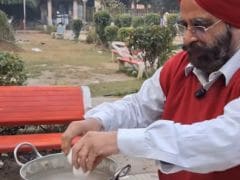It's likely to remind you of a Nike air commercial. At least that was my first thought when I sampled Banh bo (aka Honeycomb cake) at a nondescript eatery in Vietnam. I experienced the same feeling a year later in a toddy shop near Ernakulam when I tried vattayapam for the first time ever. The comparisons between the Vietnamese Banh bo (there are culinary experts who suggest that the Banh bo is a spin on the Southern Chinese bai tang gao that you might have come across in Hong Kong) and vattayapam are inevitable but for me it's the spongy textures of the vattayappam that trump the slightly stickier textures of the Banh bo.
A year ago and about two years after my first brush with the vattayappam at a toddy shop, I sampled an authentic version at Kappa Chakka Kandhari (KCK) in Chennai. It's not a dish you find in Kerala speciality restaurants but is one of the many staples that are in the spotlight at KCK. Chef Regi Mathew, Culinary Director and co-owner hails from the Central Travancore region where this snack is still very popular. He tells me that this steamed rice cake used to be originally crafted with fermented rice batter along with toddy sap (sap palmyra palm or coconut] but more recently yeast has taken over the role of the fermenting agent.
According to Regi, there are two popular variations - the Kottayam version is more often eaten as a snack while in Thrissur it's usually a breakfast staple that's served with a variety of side dishes. The Kottayam version of Vattayappam is sweeter, often garnished with raisins and it is thick and more porous as it is made with ground coconut, rice, sugar and fermented with toddy or yeast and then steamed. The Thrissur version tends to be smooth soft and spongy courtesy the smooth paste of coconut or coconut milk. I lean more towards the Kottayam version. The textures remind me of the spongy centre of the Appam, in fact the vattayappam is even more porous and light as air. I tried the vattayappam for the first time with a duck mappas, it also works really well with a dish moilee, a chicken curry or a vegetable stew. Chef Regi's convenient version (don't worry, you don't need to look for toddy for this recipe) of the vattayampam is relatively easy to try:
Vattayappam Recipe
Recipe Courtesy: Regi Mathew, Culinary Director and co-owner - Kappa Chakka Kandahari
Serves 2
Ingredients
Raw Rice - 1 cup
Sugar - 5 Tablespoon, adjust according to your taste
Cashew Nuts - 10 Nos
Raisins - 10 Nos
Cardamom powder - 1/2 Teaspoon
Ghee -1 tbsp to roast the nuts and to grease the pan
Water as required
For coconut paste:
Grated Coconut - 1 cup
Cooked Rice - 1/2 cup
Yeast - 1/2 Teaspoon
Sugar - 1 Tablespoon
Method
Pre Preparation:
Wash and soak the rice for 3-4 hours.
Strain out the water and finely grind the rice in a food processor with minimum amount of water.
Pour this mixture into a large container and set aside.
Coarsely grind together into an almost smooth consistency all the ingredients mentioned under 'for coconut paste' except the yeast.
Add this into the rice batter and combine well.
Take 2 tablespoons of lukewarm water and add the yeast into it and allow to ferment for 15 minutes. Once the yeast starts to bubble, add to the rice batter and mix well.
Cover the container and let the mixture ferment in a warm place, for about 6-8 hours or preferably overnight.
Heat 1-2 tablespoons of ghee in a pan. Add in the cashew nuts, raisins and fry until light golden in colour. Keep aside.
Add sugar, cardamom powder into the fermented batter and mix well, set aside for 30 minutes.
Steaming
Grease a round pan or cake mould with little ghee.
Pour the prepared batter and fill till 1/2 - 3/4 portion of the greased round pan.
Gently sprinkle some roasted cashews and raisins on the top.
Place it in the steamer, cook for about 20-25 minutes or until an inserted toothpick comes out clean.
Remove the pan from steamer and allow to cool. Once cooled, pull it out from the pan by slowly pulling the edges using a knife or spoon.
Cut into desired shape and serve with side dish of choice.
